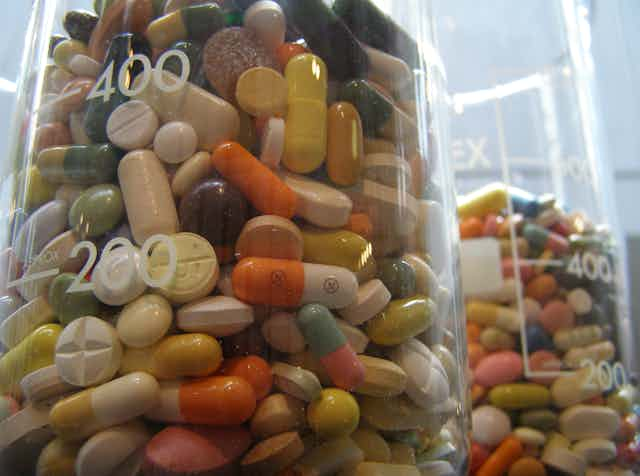India has been called the pharmacy of the world. Many generic drugs are made there and much of its drug production is exported internationally. Thousands of fixed dose combination (FDC) drugs – where two or more drugs are combined in a set ratio in a single dose form, usually a tablet or capsule – are formulated, made and sold within India.
Many FDCs are safe and effective. They are used in situations where both the drug combination and the doses needed are standardised and stable, for example, in the treatment of HIV, for Parkinson’s disease and in contraceptive pills.
However, in a study investigating these drugs in India, we found thousands of FDCs on the market made up of formulations never approved for marketing by the national regulator, the Central Drugs Standard Control Organisation, and that were likely to be more harmful than beneficial to patients.
As two pharmacologists in India, writing in response to our study put it:
One can find any crazy drug combination which could give nightmares to any doctor who has some understanding of the concept of the rational use of medicine. It is simply beyond comprehension of any rationalist. Even antimicrobials are being combined weirdly, which is a grave challenge for crusaders against antimicrobial resistance.
FDCs in India
Considered an innovation of India’s national pharmaceutical industry, FDCs are promoted extensively and used in huge numbers within the country. These drugs are mostly available through wholesalers, pharmacies (not necessarily with a prescription), dispensing doctors, but some are used in hospitals too.
For years though, there has been disquiet. In 2007, the national regulator banned 294 of the drugs because they had never been approved for marketing but had been given manufacturing licenses by authorities. FDC manufacturers disputed the ban and the matter remains unresolved in the courts. In 2012, an Indian government committee investigating the standards and capacity of the regulator issued a report highlighting multiple problems, including FDC approvals.
The committee found state authorities were issuing manufacturing licenses for new formulations that were never approved. It said: “The end result is that many FDCs in the market have not been tested for efficacy and safety. This can put patients at risk”. Many formulations were also medically unnecessary.
The report noted that “ambiguities” in the rules on new drugs prior to an amendment to existing legislation in May 2002 might have encouraged the marketing of FDCs without approval. However, we identified no ambiguities in the drug rules and found that just as many unapproved new FDCs appeared on the market after the amendment as before.
The scale of the issue
The committee’s report included no investigation of the size of the problem or potential risks to patients, so we used drug approval records (1961-2013) and commercial sales data (2007-2012) to identify approved and unapproved FDCs on the market and calculate the quantities being sold.
We examined four areas: pain-relief, diabetes, anxiety/depression, and psychosis. We chose these because the drugs are commonly used and many, even when used alone, have serious side effects.
In the four areas, we found 175 FDC formulations on the market, 115 (66%) with no record of approval. Metformin drugs for diabetes had the best approval compliance, anti-psychotics the worst.
FDC formulations give rise to many branded products made by different pharmaceutical companies, each promoting their own products in a crowded marketplace. Among anti-inflammatories, there were almost 3,000 branded products, with more than 1,000 of them made from unapproved formulations. Vast volumes of these FDC products are sold in India.

Banned or restricted in other countries
Among the products on the market, we found numerous combinations containing drugs that are banned or restricted in other countries. Some of these were formulations actually approved by the regulator, others were unapproved. They included, for example, melitracen, an antidepressant widely banned owing to central nervous system toxicity (in India its top-selling combination with flupentixol, an anti-psychotic, was banned in 2013, re-approved, then banned again in 2014, and nimesulide, an analgesic also widely banned due to its association with liver toxicity and put under sales restrictions in 2007 by the European Medicines Agency.
Several anti-inflammatories included a muscle relaxant drug banned because of damage to dividing cells in the body while yet others contained two types of anti-inflammatory together, giving no advantage for pain but increasing the risk of serious side effects including bleeding in the stomach and heart attack.
Some combinations were potentially lethal, for example, an anti-psychotic containing two drugs from the same class, both individually associated with major toxicity including sudden death. Dozens of antidepressant and benzodiazepines included combinations of sedating drugs shown individually to increase the risk of falls and accidents.
Response and remedy
Following the committee report in 2012, the Indian government made attempts to improve FDC regulation. But there was little enforcement. In fact, manufacturers lobbied against regulatory change, making “an earnest appeal” to government to “maintain status quo”, both approved and unapproved, marketed up to September 2012. And that is exactly what has happened.
It is clear from our research that drug regulation in India, a key international exporter of medicines, needs a major overhaul. Unapproved FDCs should be banned and patients transferred to appropriate single drugs. Public health, not manufacturers’ commercial concerns, should inform the regulation of India’s drugs.
But all too often, as we have found, business comes first and citizens are the losers. Alongside Indian medical and legal colleagues, we are now working to see unapproved FDCs banned once and for all and to draft a new drugs act for India. With strong and clear legislation, a most important step will be taken to ensure that in the long term the people of India have safe and effective drugs made in their country.

